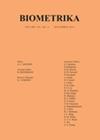A subsampling perspective for extending the validity of state-of-the-art bootstraps in the frequency domain
IF 2.8
2区 数学
Q2 BIOLOGY
引用次数: 0
Abstract
Summary Bootstrapping spectral mean statistics has been a notoriously difficult problem over the past 25 years. Many frequency domain bootstraps are valid only for certain time series structures, e.g., linear processes, or for special types of statistics, i.e., ratio statistics, because such bootstraps fail to capture the limiting variance of spectral statistics in general settings. We address this issue with a different form of resampling, namely, subsampling. While not considered previously, subsampling provides consistent variance estimation under much weaker conditions than any existing bootstrap in the frequency domain. Mixing is not used, as is often standard with subsampling. Rather, subsampling can be generally justified under the same conditions needed for original spectral mean statistics to have distributional limits in the first place. This result has impacts for other bootstrap methods. Subsampling then applies to extending the validity of recent state-of-the-art bootstraps in the frequency domain. We nontrivially link subsampling to such bootstraps, which broadens their range, as moment and block assumptions needed for these are cut by more than half. Essentially, state-of-the-art bootstraps then require no more stringent assumptions than those needed for a target limit distribution to exist, which is unusual in the bootstrap world. We also close a gap in the theory of subsampling for time series with distributional approximations, in addition to variance estimation, for frequency domain statistics.在频域扩展最先进自举的有效性的子采样视角
在过去的25年中,自举谱均值统计一直是一个非常困难的问题。许多频域自举仅对某些时间序列结构有效,例如线性过程,或对特殊类型的统计有效,例如比率统计,因为此类自举无法捕获一般设置下谱统计的极限方差。我们用另一种形式的重采样来解决这个问题,即子采样。虽然以前没有考虑过,但子采样在比任何现有的频域自举都弱得多的条件下提供一致的方差估计。不使用混合,这通常是标准的子采样。相反,在原始谱均值统计量首先具有分布限制所需的相同条件下,通常可以证明子抽样是合理的。这个结果对其他bootstrap方法有影响。然后,子采样应用于扩展最新的最先进的自举在频域的有效性。我们非平凡地将子采样与这样的自举联系起来,这扩大了它们的范围,因为这些所需的矩和块假设减少了一半以上。从本质上讲,最先进的自举方法不需要比目标极限分布存在所需的假设更严格的假设,这在自举方法世界中是不寻常的。除了方差估计外,我们还在频域统计量的分布近似时间序列的子抽样理论中缩小了差距。
本文章由计算机程序翻译,如有差异,请以英文原文为准。
求助全文
约1分钟内获得全文
求助全文
来源期刊

Biometrika
生物-生物学
CiteScore
5.50
自引率
3.70%
发文量
56
审稿时长
6-12 weeks
期刊介绍:
Biometrika is primarily a journal of statistics in which emphasis is placed on papers containing original theoretical contributions of direct or potential value in applications. From time to time, papers in bordering fields are also published.
 求助内容:
求助内容: 应助结果提醒方式:
应助结果提醒方式:


